Tundra photos

The morning sun rises over the Alaska Range mountains, lighting the crimson dwarf birch tundra, Denali National Park, Interior, Alaska. (Patrick J. Endres / AlaskaPhotoGraphics.com)
Tundra is a treeless plain of the Arctic and subarctic that has permanently frozen subsoil called “permafrost.” It is generally dominated by mixed vegetation of mosses, lichens, and dwarf shrubs. The perennially frozen ground can be from a few inches to a few feet below the surface. While the ground below remains frozen all year, the top layer that melts under the summer sun is called the active layer. It is here where the shrubs, wildflowers, and grasses proliferate during the few summer months. Since the ground below remains frozen, water can not penetrate, so the tundra is often wet and boggy. Since tundra is widely distributed across Alaska, the tundra photos here are from all parts of the state and are available for purchase as stock photography or as fine art prints to display in your home or office.

Rays of sun fall over the undulating tundra landscape of the Bering Land Bridge National Preserve, Seward Peninsula, Alaska. (Patrick J Endres / AlaskaPhotoGraphics.com)
Features of the Tundra
Tundra is a mosaic of spongy wetlands, marshes, lakes, ponds, and streams. It hosts some unique topographical features formed from repeated freeze and thaw cycles. The cold winter causes the soil to shrink, crack and buckle. Water fills these cracks when it melts in the summer, and they freeze, creating wedges. The process repeats itself, increasing the wedges’ size and changing the landscape. These dynamic features, including pingos, ice wedges, polygons, and tussocks, can slowly change yearly. The tundra photos below are some examples of these features.
Tussocks

Tundra tussocks, Utukok Uplands, National Petroleum Reserve Alaska, Arctic, Alaska. (Patrick J. Endres / AlaskaPhotoGraphics.com

A branch sticks out of the snow-covered tussocks on the tundra, Arctic, Alaska (Patrick J. Endres / AlaskaPhotoGraphics.com.
Polygons and Ice Wedges
Polygons are formed as a result of the freeze and thaw cycle. When soil contracts in the deep cold, cracks form. During spring snowmelt and summer rains, water flows into the gap and is trapped and frozen by surrounding permafrost. Freezing water expands and forces the surrounding soil upward and outward.
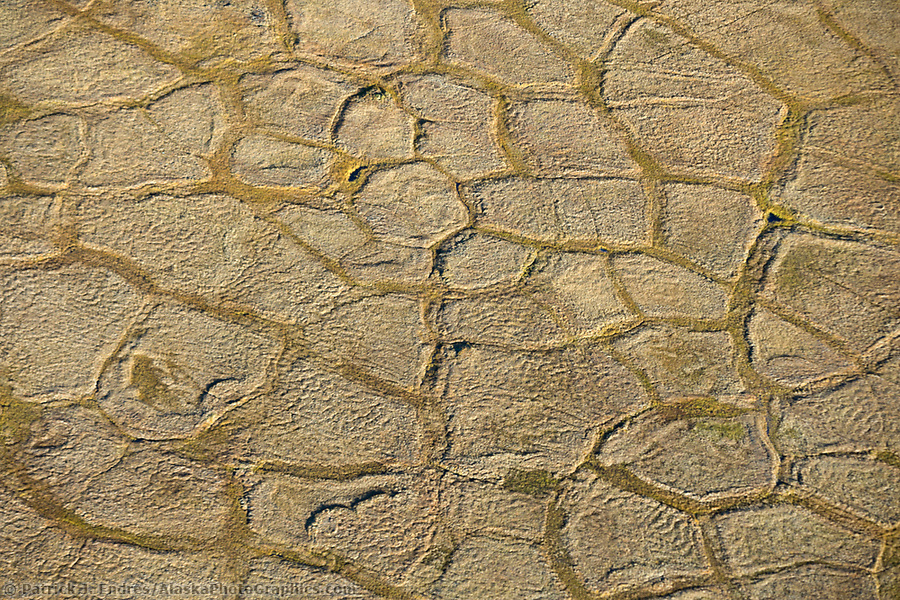
A geological feature of Polygons on the Arctic Coastal Plain of the Arctic National Wildlife Refuge, Alaska. (Patrick J. Endres / AlaskaPhotoGraphics.com)
Ponds and Thermokarsts (surface depressions)
When permafrost melts, the land slumps and fills the void, creating a surface depression or thermokarst. These thermokarsts may take on a variety of shapes.

Kettle pond on Barter Island, near the village of Kaktovik, pink Arctic sunset over tundra pond. (Patrick J. Endres / AlaskaPhotoGraphics.com)
Pingo
The word “pingo” comes from an Inupiaq name for a cone-shaped hill or mound of soil with a core of ice. An average pingo is about 100 feet (30 meters) high and 1650 feet (50 meters) in diameter. Pingos can occur in areas of both continuous and discontinuous permafrost.

A geological formation called a pingo on the tundra of Alaska’s Arctic North Slope (Patrick J. Endres / AlaskaPhotoGraphics.com)
Wetlands
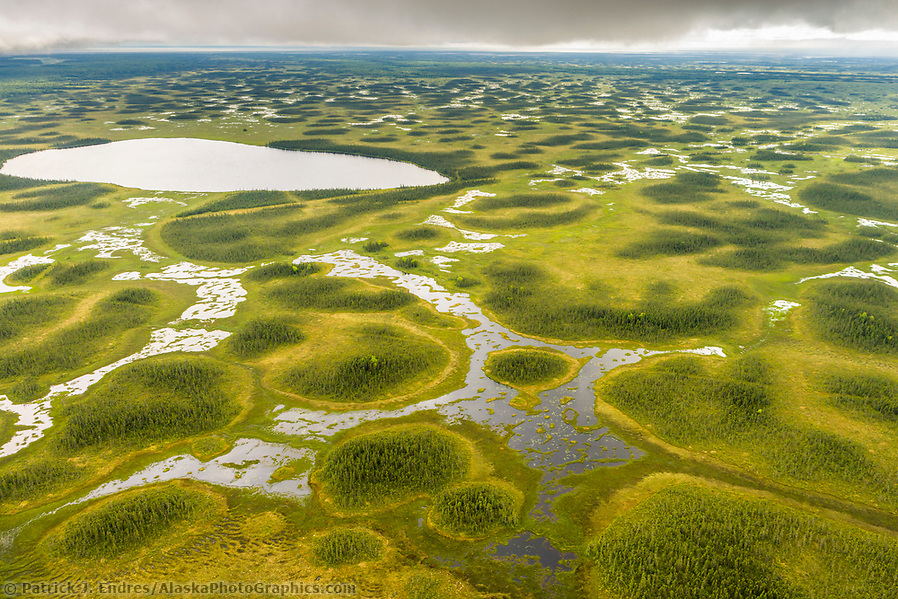
Thermokarst depressions in the tundra wetland, southcentral Alaska, west of Cook Inlet. (Patrick J. Endres / AlaskaPhotoGraphics.com)
Forest Fires
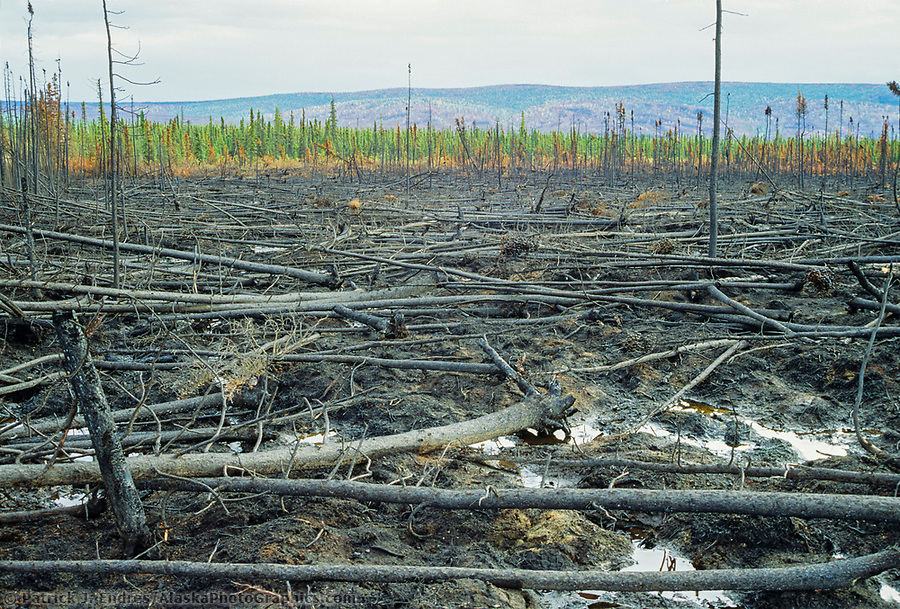
Forest fire burn in the spruce trees adjacent to the James Dalton Highway, Arctic, Alaska (Patrick J. Endres / AlaskaPhotoGraphics.com)
Meandering Streams and Rivers

Rivers wind through the flat tundra wetland area in Katmai National Park, Alaska. (Patrick J Endres / AlaskaPhotoGraphics.com)
Solifluction Lobes or Gelifluction
Because water can’t seep into the frozen underlayer of permafrost, the active layer of topsoil gets water-saturated. The weight of the soil causes the active layer to slide, or slump, downhill when thawed in summer. The rate of movement depends on the slope and amount of vegetative cover. Movement can vary from a fraction of an inch per year to an avalanche rush.

Solifluction lobes in Skookum pass, Seward Peninsula, western Arctic, Alaska. During the summer heat, underlying frozen permafrost ground acts as a sliding plane along which the soil can slowly move down the slope over time. (Patrick J. Endres / AlaskaPhotoGraphics.com)
Permafrost Ice Lens
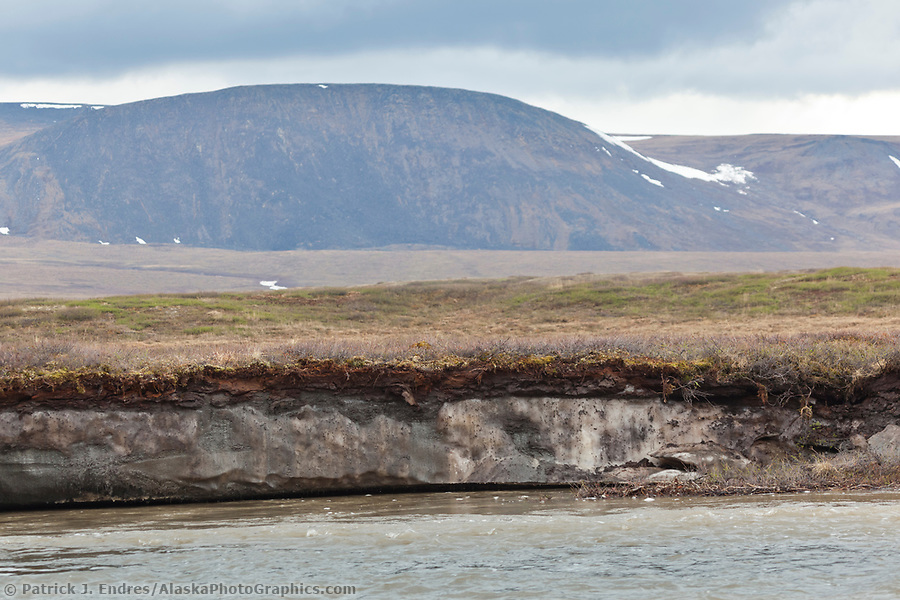
Permafrost lens exposed by erosion along the Nigu river, National Petroleum Reserve, Alaska. (Patrick J. Endres / AlaskaPhotoGraphics.com)
Plants of the Tundra
The plants that survive in the active topsoil layer of the tundra have developed unique adaptations to endure a long and cold winter. Tree growth is absent or limited because of the shallow active layer. Depending on the degree of wetness, different plants dominate the tundra. In wet areas, cotton grass and sedges are common, and in dryer areas, grasses, flowers, dwarf willows, and many flowers proliferate under a short summer.
Dwarf birch and black spruce

Autumn tundra, taiga, spruce trees, dwarf birch, Denali National Park, Alaska. (Patrick J. Endres / AlaskaPhotoGraphics.com)
Mountain Aven

Wildflowers in the Utukok Uplands, National Petroleum Reserve Alaska, Arctic, Alaska. (Patrick J. Endres / AlaskaPhotoGraphics.com)
Fireweed

Dark storm clouds and rainbow over fireweed blossoms on the tundra, Denali National Park, Alaska (Patrick J Endres / AlaskaPhotoGraphics.com)
Alpine Azalea

Alpine Azalea blossoms on the spring tundra in Denali National Park, Alaska (Patrick J. Endres / AlaskaPhotoGraphics.com)
Lapland Rosebay

Spring wildflowers Lapland rosebay and mountain aven carpet the Arctic tundra in the Brooks Range, Alaska. (Patrick J. Endres / AlaskaPhotoGraphics.com)
Wooly Lousewort

Wooly lousewort wildflowers on the tundra in the continental divide of the Brooks Range, Gates of the Arctic National Park, Alaska. (Patrick J Endres / AlaskaPhotoGraphics.com)
Alaska Cotton Grass

Alaska cotton grass in the tundra wetlands in Angiaak Pass, Gates of the Arctic National Park, Alaska (Patrick J Endres / AlaskaPhotoGraphics.com)
Purple Oxytrope

Mountain landscape of purple oxytrope blossoms on the tundra and Itkillik River in the Gates of the Arctic National Park, Alaska. (Patrick J Endres / AlaskaPhotoGraphics.com)
Animals of the tundra
Not many animals live year-round in the tundra. To avoid the harsh winter conditions, animals either migrate, hibernate, or have body insulation adaptations to withstand the super cold.
Muskoxen
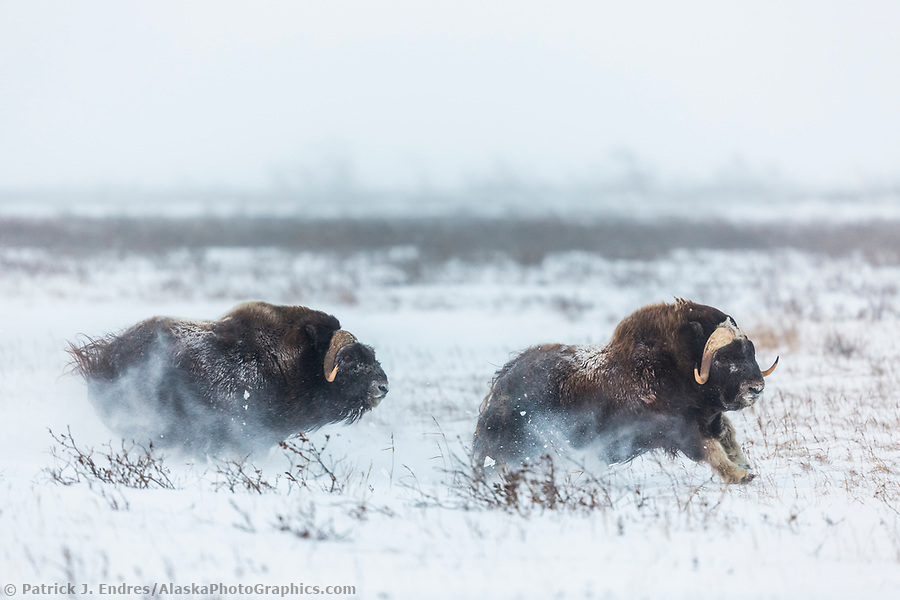
Two muskox bulls chase each other after sparring on the snowy Arctic tundra, Arctic North Slope, Alaska. (Patrick J Endres / AlaskaPhotoGraphics.com)
Arctic Wolf

Arctic wolf on the snow-covered tundra in Alaska’s Arctic. (Patrick J Endres / AlaskaPhotoGraphics.com)
Red Fox

Red fox rests on the snowy tundra of the Arctic North Slope, Alaska. (Patrick J Endres / AlaskaPhotoGraphics.com)
Arctic Fox

Arctic fox in a white winter coat stretches after a nap in a snowdrift along a lake in Alaska’s Arctic North Slope. (Patrick J. Endres / AlaskaPhotoGraphics.com)
Arctic Ground Squirrel

Ground squirrel and mountain aven wildflowers, Utukok Uplands, National Petroleum Reserve Alaska, Arctic, Alaska. (Patrick J. Endres / AlaskaPhotoGraphics.com)
Barren Ground Caribou

A caribou herd migrates over the snow-covered tundra, Philip Smith Mountains of the Brooks Range, Arctic, Alaska. (Patrick J Endres / AlaskaPhotoGraphics.com)

Large bull caribou with shedding velvet antlers walk through crimson-colored dwarf birch tundra in Denali National Park. (Patrick J Endres / AlaskaPhotoGraphics.com)
Moose

A Bull moose walks across the tundra in front of Mt. Denali, Denali National Park, Alaska. (Patrick J Endres / AlaskaPhotoGraphics.com)
Birds of the Tundra
The tundra wetlands areas can be highly productive under the brief summer, which draws many migratory birds and waterfowl to feed and raise their young.
Pacific Loon

Pacific loon swims in a tundra pond on Alaska’s Arctic North Slope. (Patrick J. Endres / AlaskaPhotoGraphics.com)
Tundra Swan
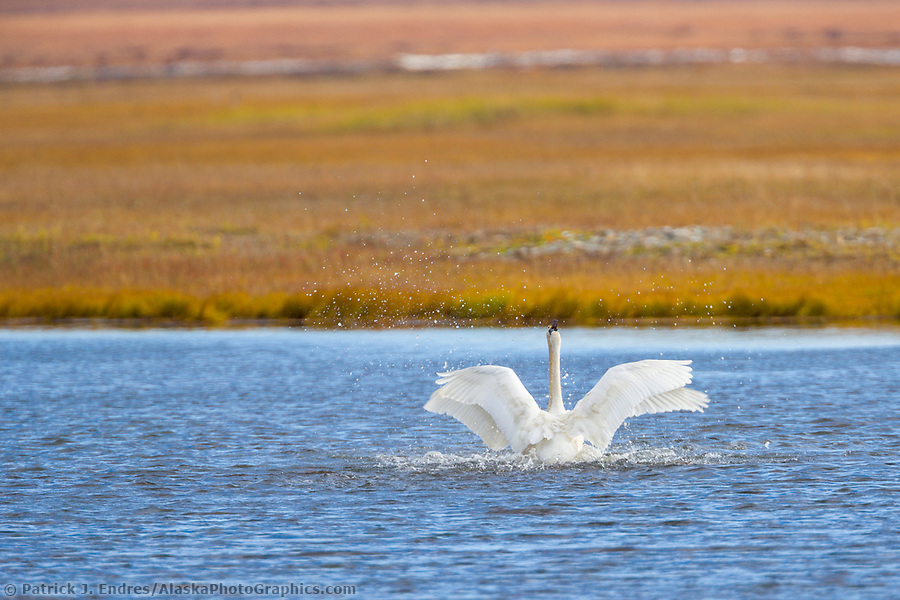
Tundra swan migrates through Solomon, Seward Peninsula, western Arctic, Alaska, during the autumn migration. (Patrick J. Endres / AlaskaPhotoGraphics.com)
Arctic Tern

Arctic tern hovering in flight, Alaska Range, Interior, Alaska. (Patrick J Endres / AlaskaPhotoGraphics.com)
Snowy Owl

A snowy owl takes flight over the snow-covered tundra of Alaska’s Arctic North Slope. (Patrick J. Endres / AlaskaPhotoGraphics.com)
Semi-palmated Sandpiper

Semi-palmated sandpiper on the tundra in mt aven wildflowers going to seed, Arctic National Wildlife Refuge, arctic Alaska. (Patrick J. Endres / AlaskaPhotoGraphics.com)
Raven

Raven takes flight through spruce trees in the morning fog, Denali National Park, Interior, Alaska. (Patrick J. Endres / AlaskaPhotoGraphics.com)
